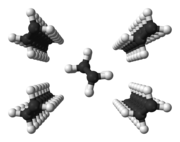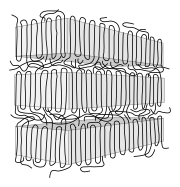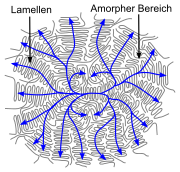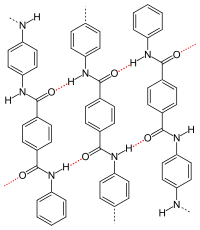User:Minihaa/polymers
Appearance
Aufgaben:
- Eine Abbildung "Homopolymer" erstellen, so wie unten schon die Copolymere aufgeführt sind.
- Eine Abbildung erstellen, die die drei Darstellungen von Polymeren (Wiederholeinheit, Kugeln, Strich) verknüpft).
Polymer structures
[edit]Bei Polymeren, die in der Hauptkette ungesättigt sind, tritt in Analogie zur cis-trans-Isomerie cis- oder trans-taktische Polymere auf, wie bei Naturkautschuk oder auch Butadien-Kautschuk. Stereospezifische Polymerisationen führen oft zu höherer mechanischer Festigkeit, höherer Kristallinität, höherer Dichte und höherer Wärmestabilität.

Ausschnitt aus einer Polymerkette von cis-1,4-Polybutadien. Eine C4-Einheit ist blau markiert.
Ausschnitt aus einer Polymerkette von trans-1,4-Polybutadien. Eine C4-Einheit ist blau markiert.
Festkörperstrukturen
[edit]The macroscopic physical properties of a polymer are related to the interactions between the polymer chains.
 Randomly oriented polymer |
 Interlocking of several polymers |
- In the solid state, atactic polymers, polymers with a high degree of branching and random copolymers form amorphous (i. e. glassy structures).[1] In melt and solution, polymers tend to form a constantly changing "statistical cluster", see freely-jointed-chain model. In the solid state, the respective conformations of the molecules are frozen. Hooking and entanglement of chain molecules lead to a "mechanical bond" between the chains. Intermolecular and intramolecular attractive forces only occur at sites where molecule segments are close enough to each other. The irregular structures of the molecules prevent a narrower arrangement.
 polyethylene: zigzag conformation of molecules in close packed chains |
 lamella with tie molecules |
 spherulite |
 Helix |
 p-Aramid, red dotted: hydrogen bonds |
- ^ Bernd Tieke: Makromolekulare Chemie. 3. Auflage, Wiley-VCH, Weinheim 2014, S. 295f.


